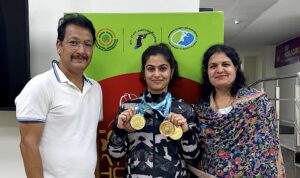
You can reach out and feel the euphoria that is hanging in the air ever since Javelin Thrower Neeraj Chopra ended India’s Olympic Games gold medal drought across 2012 and 2016. The country’s athletes have returned from the Games in Tokyo with seven medals, India’s best haul in Olympic history. And yet, Indian finished 48th on the chart of successful nations in Tokyo.
How can India become a sports powerhouse? It is a question that has engaged the country’s thought leaders and there is no harm in attempting to articulate an answer to that question as young India heads into its 75th year as an independent nation. Having said that, it must be admitted that there is no easy solution.
For a country where successive generations of people have mostly focused on food, clothing and shelter, it has only recently discovered that it can actually use sport, as a soft power, for a range of societal benefits, including nation-building. And that has led to a greater awareness about sport as career options.
More importantly, from the time Leander Paes won Olympic Games bronze in Atlanta in 1996 to end a 44-year drought of individual medals and Abhinav Bindra became the first India to win an individual gold medal in Bejing in 2008, Indian athletes have changed their mindset from merely participative at the highest level to competitive.
Yet, it takes much more for India to be a sporting powerhouse, not just an attractive market for some global sport like football and basketball which have invaded countless homes through cable and satellite. It takes the collective will of a nation, especially its people, to move forward with the thinking that competitive sport is a most useful, productive activity.
Can India break into top 10 in Olympics? The answer has to be in the affirmative, especially since the nation’ athletes cannot make any progress without that belief at the heart of their countenance. But it is not a vain boast that one would be making by saying that India can be among the top 10 nations in the none too distant future.
From my vantage position as a student of sport for more than five decades, I can see that a great ecosystem for elite athletes is falling into place. It has led to 127 athletes from 18 different disciplines making it to the Olympic Games in Tokyo. And nearly one in five has returned with an Olympic medal to show. Clearly, there must be something that India is doing right.
Of course, it will need refining, but there is no doubt that a sense of purpose binds key National Sports Federations (NSF) and the Ministry of Youth Affairs and Sports as well as Non-Government Organisations so that the elite athlete’s training and competition programme is provided for. However, there are some NSFs that have not supported their athletes as much.
There is one other strong reason that makes the journey to the top 10 in the Olympic Games a distinct possibility. Had India won three more gold in Tokyo2020, it would have been in the top 20. If the shooting team contributed a couple of gold, India would have finished higher in the medals table with more than one gold, two silver and four bronze medals.
Yet to get close to the top 10, if not the top10 itself, India will have to secure at least 10 gold medals – Italy was 10th In Tokyo2020 with 10 gold, 10 silver and 20 bronze. There will have to be more meticulous planning across several disciplines for India to achieve that objective. It also calls for more athletes to embrace a tough lifestyle away from the comfort their homes.
Let us focus a bit more on some sports that can enhance India’s medal haul in the Olympic Games. Given the investments made already in Shooting, Boxing, Wrestling and Archery, India can expect their National Federations to come up with more robust plans so that their athletes are sent to the Games with the right mindset and sharper focus.
Indians can break into the big league in sports like tennis, only with greater structured support at all levels. At the moment, talented junior athletes wanting to travel overseas to play ranking events are primarily fending for themselves without much by way of support from their NSF, the All India Tennis Association.
Besides, at some point, India will have to work towards getting medals from swimming, judo, cycling, sailing and even athletics. Of these, athletics is the best placed as a sport in which India has done well at the Asian level and has the greatest challenge as a most competitive discipline as more than 200 nations send their representatives to the Olympic Games.
So that leaves us with a question of what holds India back and what it can now do collectively to forge ahead as a sporting nation? A simple response to that will be to hope that all Indian youngsters will embrace sport as a way of life, even if as a form a recreation and even with the existing infrastructure.
Another thing that springs to the mind readily as a way forward would be for States to take greater responsibility of identifying and grooming talent at the grass-root level. There are countless youngsters who can do with some support in their journeys from the development stage to the elite level. Instead, the States focus on rewarding the elite and being in the limelight.
It is imperative that each stakeholder must accept its role within the assembly line of Indian sport rather than only aspire to celebrate the finished product and claim as its own. Surely, there is immense satisfaction in facilitating the evolution of many more athletes than ride piggy-back on the successful athletes.
But above it needs a better ecosystem at the basic level – understanding parents, great coaches who can teach the kids the fundamentals that do not need altering during their evolution and who are happy to work at the bottom of the ladder relentlessly, District and State sports associations that buy into the training programme drawn up by the respective NSFs.
If the present euphoria has to be channeled into something more lasting, those at the beginning of the assembly line will have to be encouraged to take greater ownership of the process of setting athletes off on amazing journeys to the top of their sport. There is hope that Olympic sport will come to occupy centrestage and not just collective mindspace once in two years.
This article first appeared in The Hindu Business Line on August 15, 2021.








Awesome article.Its the need of the hour.Hope action takers will come forward.
Hi Rajaraman sir, very ambotious and thoughtful write up. It’s definitely possible to achieve 10+ golds, provided the mindset of our families changes from earning a decent life for ourselves to earning fame and achievement for the nation. This dream can come true only if the required policy changes are made for securing the sportsperson’s life. The way IPL nurtured many local talents, similar academies should be encouraged in other sports. Sports in schools have to be relooked. Quality and seriousness of State level competitions should be improved. Though It’s a long and tough journey ahead, if we take serious steps in that direction, Hum honge kaamyab….